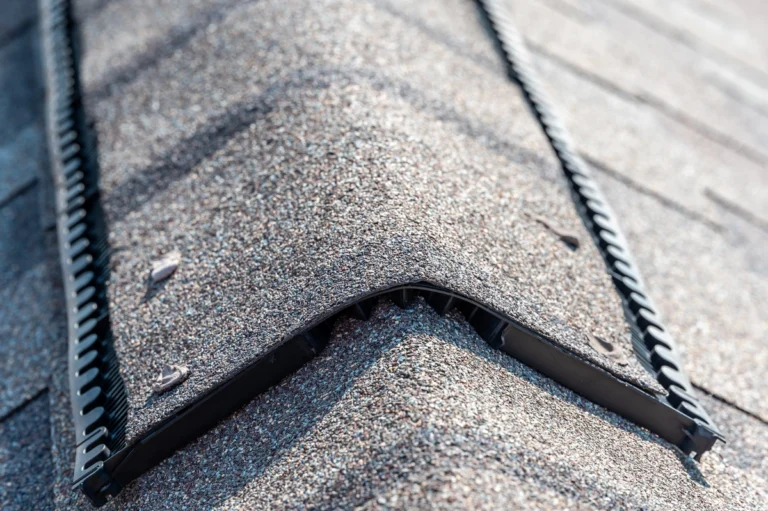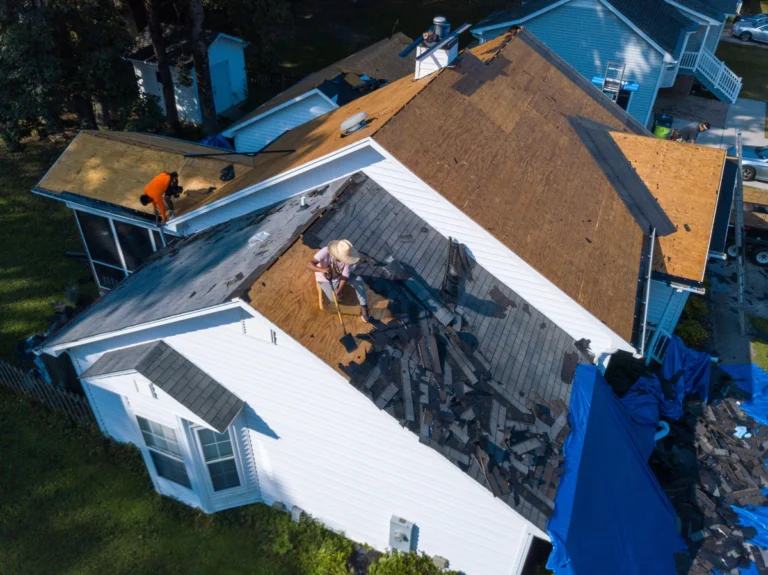Your home’s roof is an essential component that protects you and your belongings from the elements. Over time, however, even the most durable roofs can wear out, leading to the need for a replacement. When that time comes, it’s crucial to understand the:
- Process
- Timeline
- Costs involved in a roof replacement project
In this comprehensive guide, we’ll delve into the signs that indicate your roof needs replacing, when to call your roofing contractor, how long a roof replacement typically takes, the steps involved in the process, and the cost considerations.
How long does it take to replace a roof? Keep reading to get the inside scoop!

Signs That You Need a Roof Replacement
Before we dive into the timeline and steps of a roof replacement, it’s essential to recognize the signs that your roof may be in need of replacement. Identifying these signs early can save you from potential water damage and costly repairs down the line:
- Age: The age of your roof is a critical factor. Most asphalt shingle roofs have a lifespan of 20-30 years, while other materials like metal or tile can last longer. If your roof is approaching or past its expected lifespan, it’s time to consider replacement.
- Visible Damage: Inspect your roof for visible signs of damage such as missing, cracked, or curling shingles, as well as excessive granule loss. These issues can compromise your roof’s integrity and should not be ignored.
- Leaks and Water Stains: If you notice water stains on your ceilings or walls, it’s a clear indication that your roof has a leak. Address this issue promptly, as water damage can lead to more extensive problems.
- Rotting or Sagging: A sagging or rotting roof deck is a severe problem that demands immediate attention. These issues typically indicate long-term water damage and structural issues.
- Moss and Algae Growth: Excessive moss or algae growth can compromise your roof’s durability, especially in regions with high humidity. These growths trap moisture, leading to decay over time.
- Daylight Through the Roof: If you can see daylight through your attic or roof boards, it means there are holes or gaps in your roof structure, which require immediate repair or replacement.
When to Call Your Roofing Contractor
Once you’ve identified the signs that suggest your roof needs replacement, the next step is to contact a professional roofing contractor. Here are some key considerations for when to make that call:
- Regular Inspections: Schedule regular roof inspections at least once a year, especially before and after the harsh seasons. This proactive approach can help identify issues early, potentially saving you money in the long run.
- After Severe Weather: After a severe storm with hail, high winds, or heavy rainfall, it’s advisable to have your roof inspected even if you don’t notice any immediate damage. Some issues may not be visible to the untrained eye.
- Age of the Roof: If your roof is nearing the end of its expected lifespan, it’s a good idea to have it inspected by a professional. They can assess its condition and recommend whether it needs replacement or can be repaired.
- DIY Repairs Aren’t Enough: While it’s tempting to fix minor issues on your own, some problems may require professional attention. If you’ve been making frequent repairs or patching your roof, it might be time for a replacement.
- Immediate Leaks: If you discover a roof leak, contact a roofing contractor right away to assess the damage and prevent further water infiltration.
How Long Does a Roof Replacement Take?

Once you decide to proceed with a roof replacement, you may wonder how long the process will take. The duration can vary depending on several factors, including the size and complexity of your roof, the weather conditions, and the contractor’s schedule. On average, a typical roof replacement can take anywhere from a few days to a couple of weeks. Here’s a breakdown of the timeline:
Inspection and Estimate (1-2 Days):
After contacting a roofing contractor, they will schedule an inspection to assess the extent of the damage and provide you with an estimate. This initial phase usually takes one to two days.
Material Selection (Varies):
The time it takes to select roofing materials depends on your preferences and availability. Some materials may need to be ordered, which can add a few days to the timeline.
Permits and Approvals (Varies):
If your area requires permits for roofing projects, obtaining them can take some time. The duration depends on your local government’s processing times.
Preparations (1-2 Days):
Before starting the replacement, the contractor will prepare your property by moving obstacles, protecting landscaping, and ensuring the safety of the work area. This typically takes one to two days.
Roof Replacement (2-5 Days):
The actual replacement process varies based on the size and complexity of your roof. On average, it can take two to five days to remove the old roof, install the new one, and make necessary repairs.
Cleanup and Inspection (1-2 Days):
After the new roof is in place, the contractor will clean up debris and conduct a final inspection to ensure everything meets quality standards. This phase usually takes one to two days.
Final Walkthrough and Payment (1 Day):
The contractor will walk you through the completed project, address any questions or concerns, and finalize payment arrangements, typically within one day.
9 Steps in a Roof Replacement
Understanding the steps involved in a roof replacement project can help you feel more confident throughout the process. Here’s a breakdown of the essential steps:
1) Inspection and Assessment:
A roofing contractor assesses the condition of your existing roof, identifies any issues, and provides you with an estimate for the replacement.
2) Material Selection:
You’ll choose the type of roofing material, color, and style that best suits your home’s aesthetics and your budget.
3) Permit Acquisition:
If required in your area, the contractor will obtain the necessary permits to comply with local regulations.
4) Preparation:
The contractor will prepare your property by moving obstacles, protecting landscaping, and ensuring a safe work environment.
5) Old Roof Removal:
The existing roof is carefully removed, including shingles, underlayment, and flashing. Any damaged decking or structural elements are repaired or replaced.
6) Installation of New Roof:
The new roofing material is installed, along with underlayment, flashing, and vents, ensuring proper ventilation and water protection.
7) Cleanup:
The contractor will clean up debris and conduct a thorough inspection to ensure all work has been completed to high standards.
8) Final Inspection:
A final walkthrough and inspection are conducted to address any concerns and ensure your satisfaction with the project.
9) Warranty and Maintenance:
The contractor may provide you with information on your new roof’s warranty and any recommended maintenance to prolong its lifespan.
The Cost to Replace Your Roof
The cost of a roof replacement project can vary significantly depending on various factors. Some of the key factors that influence the cost include:
- Roof Size: Larger roofs require more materials and labor, which can increase the cost.
- Roof Material: The type of roofing material you choose will have a significant impact on the cost. Asphalt shingles are typically more affordable, while materials like metal, slate, or tile can be more expensive.
- Roof Complexity: Roofs with multiple angles, dormers, and complex designs may require additional labor and materials, increasing the cost.
- Removal and Disposal: Removing and disposing of the old roofing materials add to the overall cost.
- Repairs: If your roof has extensive damage or requires structural repairs, this will increase the cost.
- Labor Costs: Labor costs vary depending on your location, the experience of the roofing crew, and the complexity of the project.
- Additional Features: The inclusion of features like skylights, chimneys, or roof vents can affect the overall cost.
- Permits and Inspections: If your local government requires permits for roofing projects, you’ll need to budget for these fees.
On average, you can expect to pay between $5,000 to $15,000 for a standard asphalt shingle roof replacement on a typical-sized home. More premium materials and complex projects can cost significantly more.
Learn More About the Roof Replacement Process
Replacing your roof is a significant investment in your home’s longevity and protection. Understanding the signs that indicate a replacement is necessary, knowing when to contact a roofing contractor, and being aware of the timeline and steps involved can help you navigate the process with confidence. Additionally, considering the various cost factors allows you to budget effectively for your roof replacement project.Remember that a well-executed roof replacement not only enhances your home’s curb appeal but also ensures the safety and comfort of your family for years to come. Got questions? Contact Sundance Kitchen, Baths, & Exteriors today to get all the answers you need!





